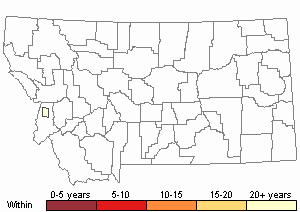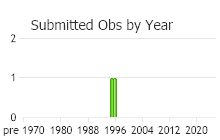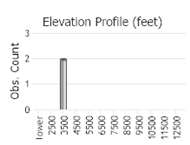View in other NatureServe Network Field Guides
NatureServe
Montana
Utah
Wyoming
Idaho
Wisconsin
British Columbia
South Carolina
Yukon
California
New York
Field Urn Moss - Physcomitrium pyriforme
Other Names:
Top Moss,
Physcomitrium megalocarpum
General Description
Plants: Acrocarpous, growing near each other without being crowded to sprinkled further apart, pale- or yellow-green. Stems from very short (0.2 cm) to tall (25 cm) (FNA 20007).
Leaves: Shriveled (Flowers 1973), twisted and bent when dry, upright to spreading when wet, lance-shaped with ovate tendencies (FNA 2007) or somewhat oblong and spathulate (Flowers 1973), the upper leaves 2-5 mm in length (FNA 2007); leaf edges flat (Crum & Anderson et al., 1981), dentate, occasionally almost entire above; costa extending to the leaf tip or rarely shortly beyond it (FNA 2007).
Leaf Cells: Upper laminal cells quadrangular to 6-sided (FNA 2007), occasionally swollen at the leaf edges for 1 or 2 rows, forming a vague border (Crum & Anderson et al., 1981); lower cells somewhat long and quadrangular (FNA 2007).
Phenology
Fruit ripens late in autumn, over the winter, and into spring (FNA 2007).
Range Comments
North American Range
Canada: BC to NS; USA: WA to CA, ID and UT, WY and CO, ND to KS, MN and IA ne and e to ME and MD respectively, AR and LA e to NC, SC, GA and FL, also KY and WV; Mexico (FNA 2007). Known in Montana from Missoula and Ravalli Counties (Elliott & Pipp, 2016).
Observations in Montana Natural Heritage Program Database
Number of Observations: 2
(Click on the following maps and charts to see full sized version)
Map Help and Descriptions
Relative Density

Recency



 (Observations spanning multiple months or years are excluded from time charts)
(Observations spanning multiple months or years are excluded from time charts)
Habitat
Moist soil in disrupted habitats (FNA 2007) such as along roads, in mudflats, grazing land, channels, along streams (Crum & Anderson et al., 1981). Occurring in lowlands and reaching the highlands (FNA 2007).
Reproductive Characteristics
Perigonia growing at the ends of lower and lateral branches, typically with club-shaped paraphyses intermingling (FNA 2007), or sometimes antheridia intermixed with archegonia in the perichaetium (Crum & Anderson et al., 1981). Perichaetia with thread-like paraphyses. Seta upright, 1-20 mm tall, carrying the capsule beyond the perichaetial bracts. Capsule 1-3 mm in length; neck short with stomata consisting of a small, narrow opening in a rounded guard cell; peristome lacking. Calyptra conical (FNA 2007).
Stewardship Responsibility
References
- Literature Cited AboveLegend:
 View Online Publication
View Online Publication Crum, H.A. and L.E. Anderson. 1981. Mosses of Eastern North America. 2 volumes. Columbia University Press, New York. 1328 pp.
Crum, H.A. and L.E. Anderson. 1981. Mosses of Eastern North America. 2 volumes. Columbia University Press, New York. 1328 pp. Elliott, J.C. and A.K. Pipp. 2018. A Checklist of Montana Mosses (1880-2018). Updated 3 January, 2020. Montana Natural Heritage Program, Helena, Montana. 73 pp.
Elliott, J.C. and A.K. Pipp. 2018. A Checklist of Montana Mosses (1880-2018). Updated 3 January, 2020. Montana Natural Heritage Program, Helena, Montana. 73 pp. Flora of North America Editorial Committee, eds. 2007. Flora of North America North of Mexico. Volume 27. Bryophytes: Mosses, Part 1. Oxford University Press, Inc., NY. xxi + 713 pp.
Flora of North America Editorial Committee, eds. 2007. Flora of North America North of Mexico. Volume 27. Bryophytes: Mosses, Part 1. Oxford University Press, Inc., NY. xxi + 713 pp. Flowers, S. 1973. Mosses: Utah and the West. Brigham Young University, Provo, Utah. 567 p.
Flowers, S. 1973. Mosses: Utah and the West. Brigham Young University, Provo, Utah. 567 p.
- Additional ReferencesLegend:
 View Online Publication
View Online Publication
Do you know of a citation we're missing? Elliot, J. C. 1993. Second checklist of Montana mosses. Unpublished report. U.S. Forest Service, Region 1. Missoula, MT. 45 pp.
Elliot, J. C. 1993. Second checklist of Montana mosses. Unpublished report. U.S. Forest Service, Region 1. Missoula, MT. 45 pp. Malcolm, B., N. Malcolm, J. Shevock, and D. Norris. 2009. California Mosses. Nelson, New Zealand: Micro-Optics Press. 430 pp.
Malcolm, B., N. Malcolm, J. Shevock, and D. Norris. 2009. California Mosses. Nelson, New Zealand: Micro-Optics Press. 430 pp. Smith, A.J.E. 1980. The Moss Flora of Britain and Ireland. Cambridge University Press, Cambridge. 705 pp.
Smith, A.J.E. 1980. The Moss Flora of Britain and Ireland. Cambridge University Press, Cambridge. 705 pp.
- Web Search Engines for Articles on "Field Urn Moss"





